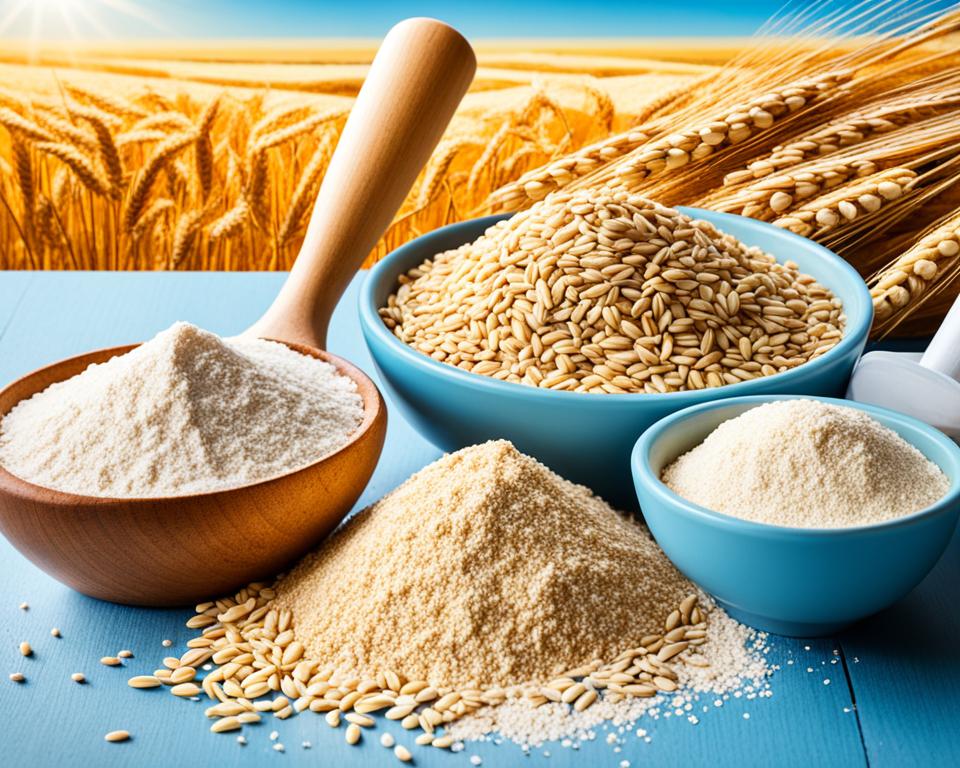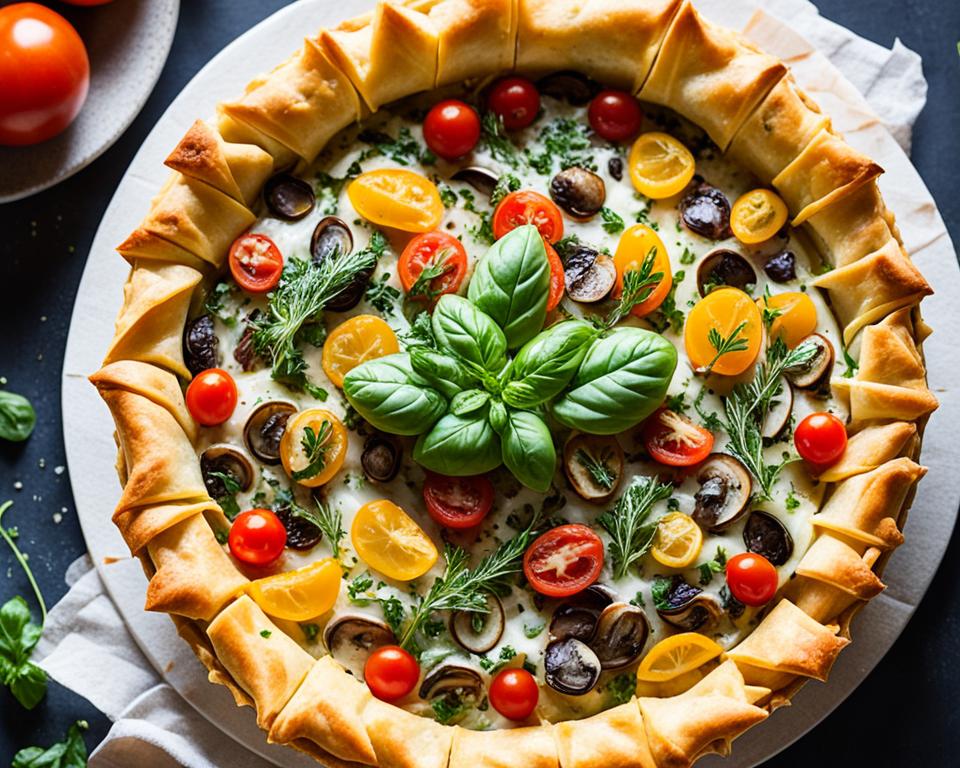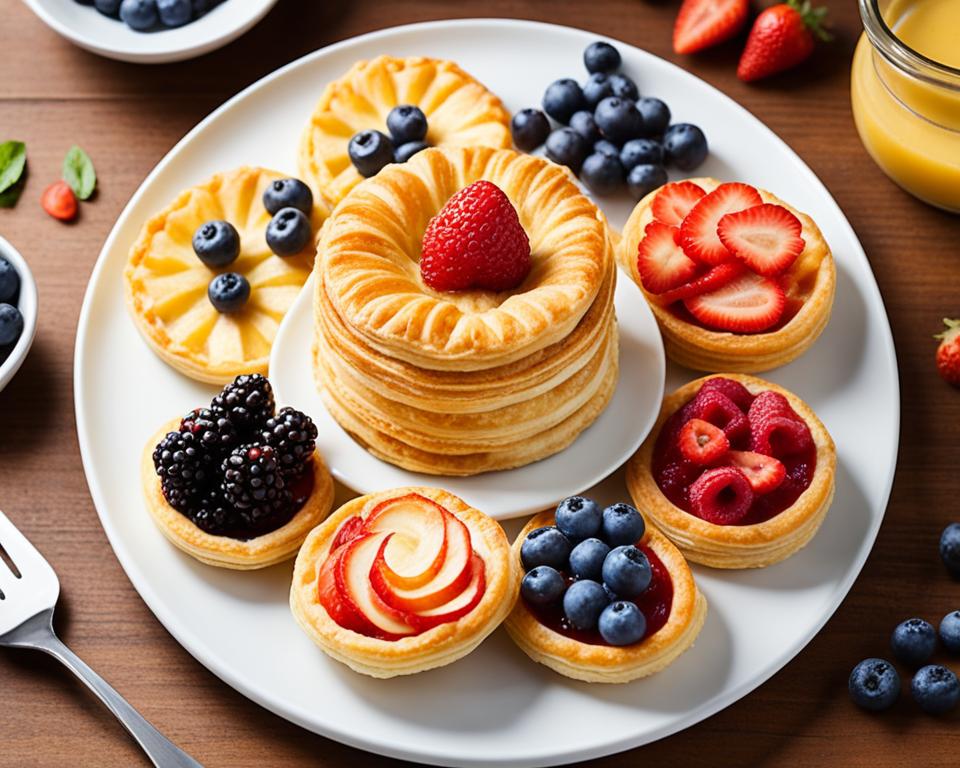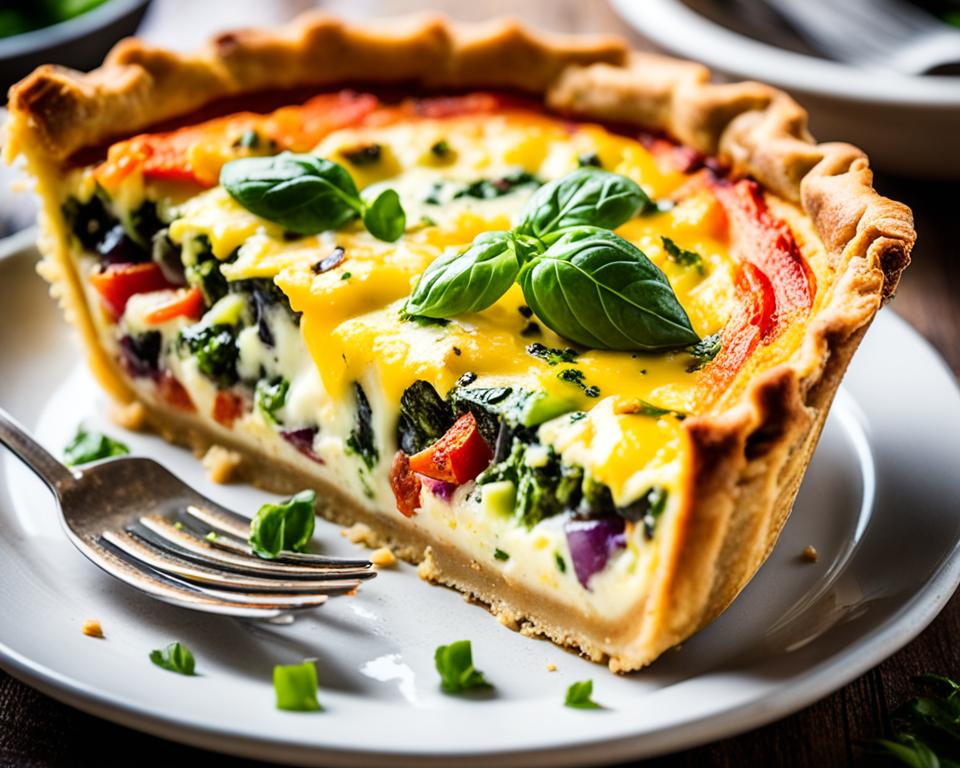Gluten-free baking can be a challenge, but with these expert tips, you can achieve perfectly flaky recipes every time. Whether you’re making pie crusts, biscuits, or puff pastries, these tips will help you master the art of gluten-free baking. Get ready to delight your taste buds with delicious gluten-free flakiness.
Key Takeaways:
- Master the art of gluten-free baking with expert tips.
- Achieve flaky goodness in your pie crusts, biscuits, and puff pastries.
- Enjoy delicious gluten-free options that rival traditional recipes.
- Use the right flour blend and techniques for optimal results.
- Impress your friends and family with your gluten-free baking prowess.
Easy Gluten-Free Puff Pastry Recipe
This gluten-free puff pastry recipe is a game-changer. It’s incredibly flaky, buttery, and tender, and it puffs up beautifully in the oven. The best part? It’s easy to make, even for beginners. With just 6 simple ingredients, you can create a gluten-free puff pastry that rivals the traditional version. Say goodbye to frozen butter and hello to flaky gluten-free deliciousness.
Are you ready to learn how to make this mouthwatering pastry? Follow the step-by-step instructions below and impress your friends and family with your baking skills!
Gather Your Ingredients:
- 2 ½ cups gluten-free all-purpose flour
- 1 teaspoon salt
- 1 cup cold unsalted butter, cubed
- 1 cup cold water
- 1 tablespoon apple cider vinegar
- 1 egg, beaten (for egg wash)
Instructions:
- In a large mixing bowl, whisk together the gluten-free all-purpose flour and salt.
- Add the cold cubed butter to the flour mixture. Using a pastry cutter or your fingertips, cut the butter into the flour until it resembles coarse crumbs.
- In a small bowl, mix the cold water and apple cider vinegar together.
- Pour the water and vinegar mixture into the flour and butter mixture. Stir until the dough comes together.
- Transfer the dough onto a floured surface and gently knead it a few times to bring it together.
- Shape the dough into a rectangle and wrap it tightly in plastic wrap.
- Refrigerate the dough for at least 1 hour, or overnight.
- Once chilled, remove the dough from the refrigerator and let it sit at room temperature for 5-10 minutes.
- On a lightly floured surface, roll out the dough into a rectangle approximately ¼ inch thick.
- Fold the dough into thirds, like a letter, and then fold it into thirds again. This creates layers in the pastry.
- Wrap the folded dough in plastic wrap and refrigerate for another 30 minutes.
- Repeat steps 9-11 two more times, chilling the dough for 30 minutes between each folding.
- Your gluten-free puff pastry is now ready to use in your favorite recipes! Whether you’re making savory turnovers or sweet danishes, this pastry will add a flaky and delicious touch to your creations.
Now that you have mastered this easy gluten-free puff pastry recipe, the possibilities are endless. Whether you’re craving a flaky pie crust or delicate palmiers, this recipe will impress your taste buds and leave you wanting more.
So why wait? Get your hands on some gluten-free all-purpose flour and start creating your own flaky pastry masterpieces today!
Perfect Gluten-Free Pie Crust
Making a gluten-free pie crust that is both flaky and delicious can be a challenge. But with this recipe, you’ll discover the secrets to creating the perfect gluten-free crust every time. From using the right flour blend to adding the right amount of moisture, these tips will help you achieve a flaky and flavorful crust for all your pie creations.
- Choose the right flour blend: Opt for a gluten-free flour blend that is specifically formulated for baking. Look for one that includes a mix of gluten-free grains and starches, such as rice flour, tapioca starch, and potato starch. This blend will provide a good texture and flavor for your pie crust.
- Add moisture gradually: When adding liquid to your pie crust dough, do so gradually. Start with a smaller amount and gradually add more as needed. Gluten-free dough tends to be more fragile, so adding too much liquid at once can make it sticky and difficult to work with.
- Use cold ingredients: Just like with traditional pie crust, it’s important to use cold ingredients when making a gluten-free version. This helps to create a flaky texture by keeping the butter or shortening solid until it melts in the oven. Chill the flour, fats, and even the water before using them in your dough.
- Don’t overwork the dough: Overworking the dough can result in a tough and dense crust. Mix the ingredients until just combined and avoid kneading or excessive handling. This will help maintain the flakiness of the crust.
“A gluten-free pie crust can be just as flaky and delicious as a traditional one, as long as you follow these simple tips,” says Emily Johnson, a gluten-free baking expert. “The right flour blend and proper handling of the dough are key to achieving a perfect gluten-free crust.”
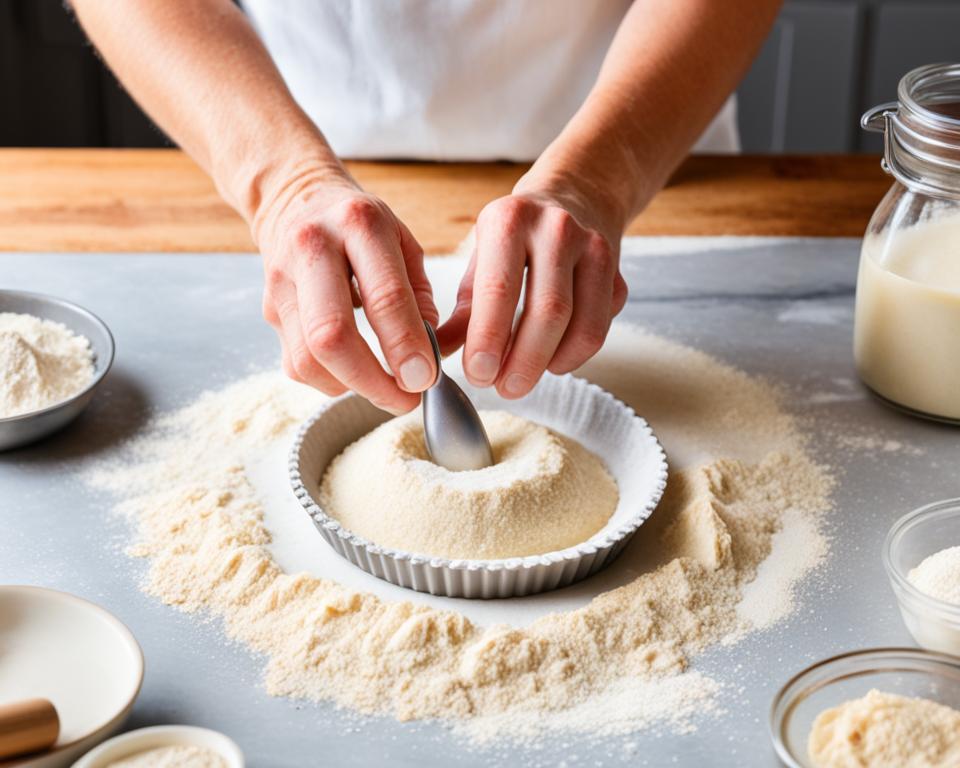
By following these secrets for the best gluten-free flaky crust, you’ll be able to enjoy pies that are just as delightful as their gluten-filled counterparts. Whether you’re craving a classic apple pie or a savory quiche, your gluten-free pie crust will be the foundation for a delicious and satisfying dessert or meal.
Tips for Gluten-Free Biscuit Recipe
When it comes to gluten-free baking, achieving that perfect flakiness in biscuits can be a challenge. But fear not! With these expert tips, you’ll be able to create gluten-free biscuits that are light, tender, and oh-so-flaky. From choosing the right flour blend to handling the dough with care, these tips will take your gluten-free biscuit recipe to the next level.
- Start with the right flour blend: Gluten-free baking requires the use of a combination of flours to mimic the texture of traditional wheat flour. Look for a gluten-free flour blend specifically formulated for baking biscuits, as it will contain a combination of flours that provide structure and tenderness to your biscuits.
- Measure ingredients accurately: In gluten-free baking, precision is key. Use a kitchen scale to measure your ingredients by weight for accuracy, especially when measuring the flour. This will ensure the proper ratio of dry to wet ingredients, resulting in better texture and flavor.
- Add a touch of xanthan gum: Xanthan gum is a common ingredient used in gluten-free baking to improve texture and help bind the dough together. Add a small amount, usually around 1/4 teaspoon per cup of gluten-free flour, to your biscuit recipe to enhance the structure and prevent them from becoming crumbly.
- Handle the dough gently: Gluten-free dough is more delicate than traditional dough, so avoid overmixing or overworking the dough. Mix the ingredients just until they come together, and then gently pat or roll out the dough to the desired thickness. Overworking the dough can result in dense biscuits.
- Chill the dough before baking: After cutting out your biscuits, place them in the refrigerator for about 15 minutes to firm up the dough. This step helps the biscuits retain their shape and prevents excessive spreading during baking.
- Bake at the right temperature: Gluten-free biscuits tend to brown faster than their gluten-containing counterparts. To prevent over-browning, bake your biscuits at a slightly lower temperature than the recipe calls for, and keep a close eye on them as they bake. They should be golden brown on the outside and cooked through on the inside.
By following these tips, you’ll be able to create delicious gluten-free biscuits that are light, flaky, and full of flavor. So go ahead, grab your apron and get ready to enjoy the irresistible goodness of gluten-free biscuits.
Mastering Gluten-Free Puff Pastry
Gluten-free puff pastry may seem like a daunting task, but with these tips, you’ll master it in no time. From choosing the right flour blend to properly laminating the dough, these expert tips will help you achieve the flakiest gluten-free pastry imaginable. Get ready to impress your friends and family with homemade gluten-free croissants, turnovers, and more.
Choose the Right Flour Blend
When it comes to gluten-free puff pastry, the flour blend you use is crucial. Opt for a blend that includes a mix of gluten-free flours, such as rice flour, tapioca flour, and potato starch. This combination will help mimic the texture and structure of traditional pastry dough.
Properly Laminate the Dough
Lamination is the process of layering butter between thin sheets of dough, resulting in the flaky layers that make puff pastry so irresistible. To achieve this with gluten-free dough, make sure to keep your butter and dough cold throughout the process. Cold ingredients help create distinct layers, resulting in a lighter and flakier texture.
“The key to successful gluten-free puff pastry lies in the lamination process. It’s essential to keep the butter and dough cold to achieve those beautiful flaky layers.” – Chef Emily Johnson
Handle the Dough with Care
Gluten-free dough can be more delicate and prone to tearing than traditional dough. When handling your gluten-free puff pastry, be gentle and avoid overworking the dough. The goal is to keep those butter layers intact, as they will create the signature flaky texture.
By following these gluten-free puff pastry tips, you’ll be able to create pastries that are just as delicious and flaky as their gluten-filled counterparts. With a little practice and patience, your homemade gluten-free croissants and turnovers will be the talk of the town.
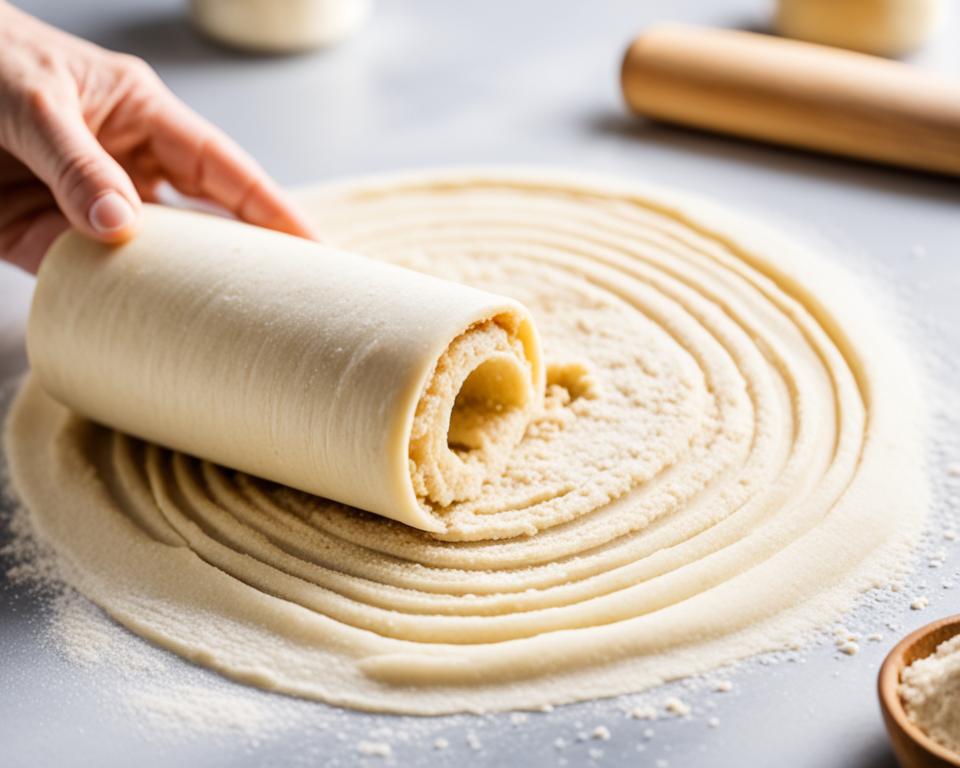
Gluten-Free Croissants: A Flaky Delight
Indulge in the buttery, flaky goodness of gluten-free croissants with these expert tips. Contrary to popular belief, you can create gluten-free croissants that rival their traditional counterparts. By mastering the art of creating the perfect laminated dough and using the right techniques for shaping and baking, you’ll achieve flaky gluten-free croissants that will delight your taste buds.
Creating the perfect laminated dough is the foundation of a successful gluten-free croissant. Here are the key tips to keep in mind:
- Start with a high-quality gluten-free flour blend. Look for a blend specifically formulated for pastries to ensure the right texture and structure.
- Keep all your ingredients, including the flour and butter, cold throughout the process. This helps create the flakiness that croissants are known for.
- Use a butter substitute that is suitable for laminating. Look for brands that offer a gluten-free option.
- Take your time when rolling and folding the dough. This process creates the layers that give croissants their signature flakiness. Be patient and avoid rushing through this step.
Once you have your laminated dough ready, it’s time to shape and bake your croissants:
- Dust your work surface with gluten-free flour to prevent sticking.
- Roll out the dough into a large rectangle, ensuring it’s of even thickness.
- Cut triangles from the dough, making sure they are wide enough to accommodate the desired size of your croissants.
- Gently stretch each triangle and roll it up, starting from the wide base towards the pointed end.
- Place the shaped croissants on a baking sheet lined with parchment paper.
- Allow the croissants to proof in a warm, draft-free area until they have doubled in size.
- Preheat your oven to the recommended temperature and bake the croissants until they are golden brown and beautifully puffed.
With these tips in mind, you’ll be able to create gluten-free croissants that are light, flaky, and utterly delicious. Say goodbye to the limitations of gluten-free baking and indulge in the mouthwatering delight of gluten-free croissants.
The Secrets of Gluten-Free Puff Pastry
Creating gluten-free puff pastry that is light, flaky, and absolutely delicious may seem like a daunting task. But fret not, because we have the secrets to help you achieve puff pastry perfection! By following these expert tips, you’ll be able to create gluten-free puff pastry that rivals the traditional version in both taste and texture.
One of the key secrets to achieving flaky gluten-free puff pastry lies in proper dough chilling. When you chill the dough thoroughly, it allows the butter to solidify, creating distinct layers when baked. This is what gives puff pastry its signature flakiness. Be sure to wrap the dough tightly in plastic wrap and refrigerate it for at least an hour before rolling it out.
Another important tip is to use the right rolling techniques. Roll the dough gently and evenly to maintain the integrity of the butter layers. Avoid pressing too hard or overworking the dough, as this can result in a dense and heavy pastry. To make rolling easier, dust your work surface and rolling pin with gluten-free flour to prevent sticking.
Additionally, consider using a technique called “laminating” the dough. Laminating involves folding layers of butter into the dough, which creates even more flakiness. To do this, roll out the dough, place a sheet of cold butter over it, and fold the dough over the butter. Repeat this process a few times, chilling the dough in between each fold. The result will be beautifully layered and flaky puff pastry.
And now, it’s time for a visual treat! Take a look at this mouthwatering gluten-free puff pastry:

A Glance at Gluten-Free Puff Pastry
| Ingredient | Quantity |
|---|---|
| Gluten-free flour blend | 2 cups |
| Butter, cold and cubed | 1 cup |
| Salt | 1/2 teaspoon |
| Cold water | 1/2 cup |
These measurements are just a starting point. Adjustments can be made based on the specific gluten-free flour blend you’re using and the desired consistency of your dough.
“Gluten-free puff pastry is a delicate and delightful creation that requires patience and precision. By following the techniques and tips mentioned above, you’ll be able to enjoy the flakiest gluten-free pastry you’ve ever tasted.”
Now that you’re armed with these secrets, it’s time to embark on your gluten-free puff pastry journey! Practice these tips, be patient with the process, and soon you’ll be enjoying the heavenly taste and texture of homemade gluten-free puff pastry.
Achieving Flaky Gluten-Free Biscuits
Gluten-free biscuits can be tricky to get right, but with these tips, you’ll be able to achieve that coveted flakiness. When it comes to gluten-free baking, using the right flour blend is key. Look for a mix that includes a combination of gluten-free flours such as rice flour, almond flour, and tapioca flour. This blend will help mimic the structure and texture of traditional biscuits.
Another important factor in creating light and tender gluten-free biscuits is the leavening agents. To ensure a good rise, make sure to add the right amount of baking powder or a combination of baking powder and baking soda. Remember to measure accurately, as too much or too little can affect the texture of the biscuits.
When it comes to handling the dough, be gentle. Gluten-free dough tends to be more delicate than its gluten-filled counterpart. Avoid overmixing or overworking the dough, as this can lead to tough biscuits. Instead, mix the ingredients just until they come together.
Finally, pay attention to the baking time and temperature. Gluten-free biscuits may require slightly longer baking times to achieve the perfect flakiness. Keep an eye on the biscuits and remove them from the oven when they are golden brown on top.
By following these tips, you’ll be on your way to enjoying light and tender gluten-free biscuits. Good luck and happy baking!
Gluten-Free Biscuit Recipe:
| Ingredients | Instructions |
|---|---|
|
|
The Art of Gluten-Free Puff Pastry
Creating gluten-free puff pastry is truly an art form. With the right techniques and ingredients, you can achieve a flaky and buttery pastry that will amaze your taste buds. Follow these expert tips to master the art of gluten-free puff pastry and create pastries that rival those found in professional bakeries.
- Choose the right ingredients: Start with a high-quality gluten-free flour blend. Look for a blend that contains a combination of flours like rice flour, tapioca flour, and potato starch. These flours will help provide structure and create a light and flaky texture.
- Keep everything cool: Gluten-free dough can become sticky and difficult to work with if it gets too warm. Make sure to chill your ingredients, including the flour, butter, and water. This will help keep the dough manageable and prevent it from becoming too sticky.
- Properly fold and roll the dough: Folding and rolling the dough are essential steps in creating flaky layers. Divide the dough into sections and roll it out thinly. Fold the dough over itself and repeat this process several times to create layers. This will give your puff pastry its signature flakiness.
- Don’t overwork the dough: Gluten-free dough can be more fragile than traditional dough, so avoid overworking it. Handle the dough gently and avoid excessive kneading or stretching.
“The key to achieving flaky gluten-free puff pastry lies in the technique of folding and rolling the dough. By layering the dough, you create pockets of butter that melt during baking, resulting in those beautiful flaky layers.”
With these tips in mind, you’re ready to embark on your gluten-free puff pastry journey. Remember, practice makes perfect, so don’t be discouraged if your first attempt isn’t perfection. Keep honing your skills and soon you’ll be able to create gluten-free pastries that are truly works of art.
Tips for Working with Gluten-Free Puff Pastry
Working with gluten-free puff pastry requires a delicate touch and attention to detail. Here are some additional tips to ensure success:
- Always use cold ingredients to keep the dough firm and pliable.
- Use a light touch when rolling and handling the dough to prevent it from becoming too dense.
- Chill the shaped pastries before baking to help them maintain their shape and rise properly in the oven.
- Bake the pastries in a hot oven to create steam and encourage puffing.
- Allow the pastries to cool completely before enjoying to fully appreciate their flakiness.
By incorporating these tips into your gluten-free puff pastry baking routine, you’ll be able to achieve the ultimate flaky texture and indulge in irresistible homemade pastries.
Gluten-Free Pie Crust: A Flaky Foundation
The key to a great gluten-free pie is a flaky crust. With the right techniques and ingredients, you can achieve a gluten-free pie crust that is both flaky and flavorful. Follow this gluten-free pie crust tutorial to create the perfect foundation for your favorite pies.
Choosing the Right Flour Blend
When making a gluten-free pie crust, it’s essential to use the right flour blend. A combination of gluten-free flours, such as rice flour, tapioca flour, and potato starch, can help mimic the texture of traditional pie crusts. Experiment with different flour blends to find the one that works best for you.
Handling the Dough with Care
Gluten-free pie crust dough can be delicate and prone to breaking apart. To prevent this, handle the dough gently and avoid overworking it. Roll out the dough between two sheets of parchment paper to make it easier to handle. If the dough becomes too soft, refrigerate it for a few minutes before continuing.
Baking at the Right Temperature
Ensure that your oven is preheated to the correct temperature before baking your gluten-free pie crust. This will help the crust to set and become flaky. Follow the recipe instructions for the recommended baking temperature and time.
| Tip | Description |
|---|---|
| Use Cold Ingredients | When making your gluten-free pie crust, use cold butter or shortening, as well as ice water. Cold ingredients help create a flakier crust. |
| Chill the Dough | After making the dough, refrigerate it for at least 30 minutes before rolling it out. This will help prevent shrinkage during baking. |
| Blind Bake the Crust | If you’re making a pie with a wet filling, consider blind baking the crust before adding the filling. This will help maintain a flaky texture. |
Follow these tips and tricks to create a gluten-free pie crust that is both flaky and delicious. With a little practice, you’ll be able to enjoy perfect gluten-free pies with a crust that rivals any traditional recipe.
The Versatility of Gluten-Free Pastry
Gluten-free pastry is incredibly versatile, offering a world of possibilities for creating delicious and flaky treats. Whether you have a sweet tooth or prefer savory delights, gluten-free pastry can be used to make a wide variety of dishes that will satisfy your cravings. From pies and tarts to turnovers and empanadas, the options are endless.
One of the great things about gluten-free pastry is that it can be easily customized to suit different dietary preferences and restrictions. You can experiment with various flour blends, such as almond flour, rice flour, or a combination of gluten-free flours, to find the perfect texture and taste for your pastries. This versatility allows individuals with gluten intolerance or celiac disease to enjoy their favorite baked goods without compromising on flavor or flakiness.
When it comes to creating gluten-free flaky pastry, it’s important to pay attention to the techniques involved. Properly chilling the dough, using the right rolling techniques, and being mindful of the moisture content are crucial steps that can make a significant difference in the final result. Embrace the experience of working with gluten-free pastry dough and don’t be afraid to get creative!
If you’re looking for inspiration, here are a few delightful gluten-free pastry recipes that you can try:
| Recipe | Description |
|---|---|
| Gluten-Free Blueberry Galette | A rustic and free-form tart filled with juicy blueberries and wrapped in flaky gluten-free pastry. |
| Spinach and Feta Hand Pies | Delicious handheld snacks filled with a savory combination of spinach, feta cheese, and herbs. |
| Apple Turnovers | Sweet and tangy apple filling encased in a buttery gluten-free pastry, perfect for snacking or dessert. |
With these recipes and tips for creating gluten-free flaky pastry, you can indulge in a wide range of delectable treats that are both gluten-free and incredibly delicious. So go ahead, unleash your creativity in the kitchen, and enjoy the versatility of gluten-free pastry.
Conclusion
With these gluten-free baking tips, you can confidently create flaky and delicious pastries that rival their gluten-filled counterparts. Whether you’re craving a buttery croissant or a perfect pie crust, these tips will help you achieve gluten-free baking success.
Mastering the art of gluten-free puff pastry is made easy with the right flour blend and proper folding techniques. With a little practice, you’ll be able to create light and airy pastries that will impress even the most discerning pastry connoisseur.
When it comes to gluten-free croissants, the secret lies in using the right ingredients and shaping techniques. By following these tips, you’ll be able to enjoy buttery, flaky croissants that are free from gluten but full of flavor.
So why settle for store-bought gluten-free baked goods when you can create your own? With these gluten-free baking tips, you’ll have the confidence to bake flaky pastries that will satisfy your cravings and amaze your loved ones. Get ready to indulge in gluten-free baking perfection!
FAQ
What are some tips for achieving flaky gluten-free pastries?
Some tips for achieving flaky gluten-free pastries include using the right flour blend, handling the dough with care, and properly chilling the dough before baking.
How can I make an easy gluten-free puff pastry?
An easy gluten-free puff pastry can be made by using just 6 simple ingredients and following a specific method of folding and rolling the dough.
What are the secrets to creating the best gluten-free pie crust?
The secrets to creating the best gluten-free pie crust include using the right flour blend, adding the right amount of moisture, and handling the dough gently.
What tips can help me achieve a light and flaky gluten-free biscuit?
Tips for achieving a light and flaky gluten-free biscuit include using the right flour blend, using the right amount of leavening agents, and handling the dough with care.
How can I master the art of gluten-free puff pastry?
To master the art of gluten-free puff pastry, it is important to choose the right ingredients, properly laminate the dough, and use the right techniques for folding and rolling.
What are some tips for making gluten-free croissants?
Some tips for making gluten-free croissants include creating the perfect laminated dough, using the right techniques for shaping and baking, and adding buttery flavor.
What are the secrets to achieving the flakiest gluten-free puff pastry?
The secrets to achieving the flakiest gluten-free puff pastry include properly chilling the dough, using the right rolling techniques, and achieving the perfect balance of fat and flour.
How can I achieve flaky gluten-free biscuits?
To achieve flaky gluten-free biscuits, it is important to use the right flour blend, handle the dough with care, and properly work the ingredients together.
What are some tips for achieving the perfect gluten-free puff pastry?
Some tips for achieving the perfect gluten-free puff pastry include using the right flour blend, properly laminating the dough, and using the right techniques for shaping and baking.
How can I create a flaky gluten-free pie crust?
To create a flaky gluten-free pie crust, it is important to use the right flour blend, handle the dough gently, and properly chill the dough before baking.
What can I make with gluten-free pastry?
With gluten-free pastry, you can make a variety of delicious baked goods such as pies, tarts, turnovers, and more.
What are some final tips for gluten-free baking?
Some final tips for gluten-free baking include experimenting with different flour blends, following recipes carefully, and never giving up on achieving flaky perfection.

